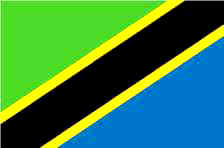|
To
Navigate Nested Pages Click on the Buttons Below

To
Navigate Between Sections Click on the Buttons at the Top of Each Page
To Return to the Top of
any Page Click on the Title Banner at the Bottom of the Page
| |
 Fact
Sheet – The United Republic of Tanzania
Fact
Sheet – The United Republic of Tanzania
Tanzania
is in East Africa, just (6°)
South of the Equator. It is
famous for Mount Kilimanjaro (the highest mountain in Africa), the
Serengeti national park, the Masai people, and the idyllic beaches on
Zanzibar.
 Tanzania
is around 8 times the land area of the UK (or half the land area of
Western Europe), and has just over half the population (36 million) of UK. About half the population of Tanzania are under 15 years old. Tanzania
is around 8 times the land area of the UK (or half the land area of
Western Europe), and has just over half the population (36 million) of UK. About half the population of Tanzania are under 15 years old.
Most
people in Tanzania speak two languages, Swahili (the language of business,
primary schools, TV, Radio etc), and their own tribal language (which they
speak at home). There are
more than 120 different tribes in Tanzania.
About ⅓ of the people in Tanzania are
Moslems, ⅓ Christian, and ⅓ follow traditional religions.
Tanzania has been a multiparty democracy since 1995.
The present President, Benjamin Mkapa steps down at the end of
2005.
 The
Tanzania flag is blue (for water), green (for land), gold (for minerals)
and black (for the people) The
Tanzania flag is blue (for water), green (for land), gold (for minerals)
and black (for the people)
Tanzania
weather is divided into wet and dry seasons.
In Mpwapwa it rains from December to April – it should rain
almost every day quite heavily (for 2 or 3 hours).
After that you will not need your umbrella again until the
following December as it will not rain a drop again.
It is cold enough (17°C)
to need a blanket at night from February to June, and hot enough (+45°C)
to make air conditioning desirable from October to February.
Some areas of Tanzania grow coffee, and sisal (to make sacking and ropes)
for export. Other exports are
gold, diamonds, and cloves and other spices (from Zanzibar and Pemba).
Near Mpwapwa it is too dry to grow crops to sell.
Most people are subsistence farmers – they have no paid
employment, but depend on growing enough food to feed their families.
Some work as tailors, or carpenters, or run corner shops to try and
make money to live. Average
income in Mpwapwa is about £60 for each person in the household per year.
Only 1 in
10 children will get a chance to go to Secondary School.
About a third of the class in the town, but only on average one
child per year from village schools will be given a place, but many
parents cannot afford the £50 per year fees to enable them to go.
Secondary education is in English.
 One
in five children who are born safely will die before their 5th
birthday, mainly from Malaria, pneumonia, diarrhoea and measles, with
malnutrition making this more likely.
One in 20 women will die from complications of one of their
pregnancies. One
in five children who are born safely will die before their 5th
birthday, mainly from Malaria, pneumonia, diarrhoea and measles, with
malnutrition making this more likely.
One in 20 women will die from complications of one of their
pregnancies.
One in 9
people are infected with a virus called HIV, which causes AIDS.
These people will almost all die in the next 5 – 10 years.
There are already many orphans, and also many skilled people such
as teachers have died, leaving the work force very short of trained
people. Many groups are
working on trying to help people avoid being infected by the virus.
To
Download a Printable Version of this Fact Sheet Please click here ► 
To
Download a Printable Prayer Book Mark Please click here ► 
Haven't
got an Adobe® Acrobat Reader? Download it from here!►


Tanzania
| Mpwapwa | St.
Luke's Clinic | The
Building Surveyor | WEB Site Map
| Can I Help?
|